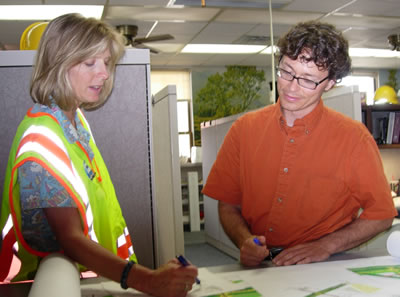By Nick Carpenter

Rebecca Arndt, public affairs coordinator, and Peter Harff, project manager, review plans for an upcoming District 7 construction project. Photo by Nick Carpenter |
Long before construction commences on a highway project, a meticulous planning regimen must take place. Those who manage a project in its early stages must consider a variety of important issues, including environmental impacts, land acquisition and, in some cases, historical preservation. Managing these issues and identifying solutions is often a collaborative effort with the community and various stakeholders that requires hours of work.
For the past eight years in his position as project manager, Peter Harff has served as a community liaison of sorts and helped plan for some of District 7’s lengthiest construction undertakings.
In late August, Harff will take some time away from his normal work duties, far away in fact. Harff and his family are moving to the Czech Republic for nine months, where he plans to write a book, train for adventure racing competitions and ride a bicycle to the Alps. In the meantime, Harff has a lot of work to do before he heads to Eastern Europe.
What projects are keeping you busy these days?
I just finished up work on the Hwy 169 project through St. Peter not too long ago. We worked with a lot of different partners including the Minnesota State Historic Preservation Office and the city of Saint Peter as we tried to balance the role of this highway as an interregional corridor, a main street and an element in an historic district. That project was funded by stimulus money and construction is now underway as a design-build.
I spend most of my time on the Hwy 60 project between Bigelow and Worthington . That project was accelerated by Chapter 152 bonding money (from the 2008 legislative session) and will be completed in three overlapping phases between 2010 and 2013.
I’m also working on the Environmental Impact Statement between New Ulm and Mankato and a couple of other, smaller projects.
Do you have a favorite project?
Obviously the St. Peter project is up there, but I have to say the Hwy 60 project is my baby. It was my first project. I used to go door-to-door and talk with the residents and business owners. Who I am as an engineer and project manager really grew out of my experiences and interactions with others working on it. I made a lot of mistakes, did some things right, and learned a ton in the process.
I also really enjoyed working on the statewide scoping effort. It was a good group of people, with good leadership, and we produced some very useful material quickly. It also gave me the chance to meet and learn from people from many different districts.
So, what happens with your projects when you leave next month?
They get passed on to my very capable colleagues. It hurts leaving some of those projects, but it’s great knowing that they’re in good hands.
What sparked your interest in engineering?
Well, it helps that I have two older siblings who are engineers, but I’d have to point to an experience that really changed my life.
When I was in my early 20’s, I spent 22 months as a missionary in Argentina. When I came back to the U.S., I was not only 20 pounds lighter because of the bugs in the water, I had a pretty good idea of what I wanted to do with my life. I wanted to learn about water treatment.
After this awakening, I decided it was better to stop studying architecture and pursue civil engineering. I ended up receiving degrees in geology and geological engineering, which is a subset of civil engineering.
What do you find most satisfying about your job?
I believe very strongly in our system of government because it answers to the people. It gives me great satisfaction being the face for the government in working with the people affected by our decisions. I think that as we function truly as public servants that it might do a little to reinforce peoples’ confidence in and respect for government.
I love going to public meetings and talking with people. I’m supposed to be an introvert, but I sure get a charge out of a roomful of people all wanting to give their insights into a project. I find it interesting to see how individuals deal with things that will affect them negatively, knowing that in the end, the project is for the greater good of the community.
Do you or a co-worker have an interesting job to share with readers? Click here to send us your ideas, and we’ll contact you for more information.
Recent employee profiles:
|



